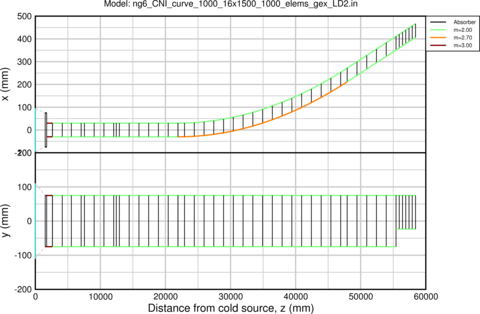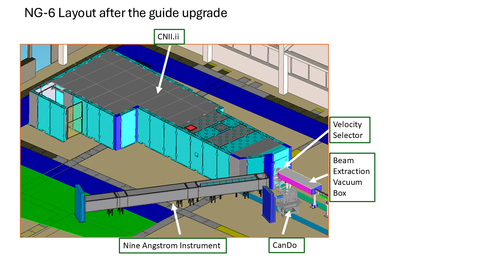The new NG-6
NG-6 has provided neutrons to three monochromatic side positions (including αα-γγ which will move to NG-7) and the Cold Neutron Imaging Instrument (CNII). The current NG6 guide is straight and thus CNII suffers from core γ-rays and fast neutrons. The many guide cuts also introduce non-uniformity into the neutron distribution, which is undesirable for an imaging station. Finally, the shielded instrument area is not as long as one might wish. The new NG-6 and cold neutron imaging instrument is designed to address these issues.
To eliminate unwanted radiation from the reactor, the new NG-6 will be curved slightly to eliminate line-of-sight to the reactor core. It is well known that curved guides introduce unwanted beam inhomogeneities. To reduce this problem, the guide will use a technique called phase-space tailoring which uses a curved section with a higher m coating on the outer radius followed by a straight section that clips off the unwanted phase space populated by the most highly divergent neutrons. This provides a perfectly uniform spatial distribution for neutrons above a certain wavelength (in this case about 3 Å), which is determined by the chosen m-coatings. Due to this, as well as imperfect illumination and non-perfect coatings, there is a very minor deviation from uniformity of perhaps 2%. The capture flux at the end of the guide will be about 6 x 109 n/cm2-s, a factor 3 gain in flux over the current guide.

The diagram below shows the guide profile. Note the dimensions of the x and y axes are very different distorting the guide shape allowing one to clearly see the curve. Note that the end of the guide is out of the line-of-sight by more than 30 cm. The vertical lines in the figure delineate each segment of the guide, while the color on the edge refers to the guide coating. The side view shows that the bottom section ends upstream of the new imaging station allowing two monochromators to be installed to serve the CANDO and 9A 3-grating far field interferometer, which will not interfere with the imaging station.
The unplanned outage has presented an opportunity to also enhance the capabilities of the cold neutron imaging instrument, located at the end of NG-6. As already mentioned, curved, m=2 supermirror guides will eliminate backgrounds due to fast neutrons and gamma rays and result in a factor of more than 3 gain in thermal equivalent flux over the present straight 58Ni guides. The relocation of the α - γ instrument permits lengthening the hutch by about 5 m, so that the maximum flight path is about 15 m. As well, there is space to have a permanently installed double monochromator assembly and velocity selector so that transitioning between polychromatic and monochromatic measurements will not require changing the elevation of the optical axis. These new features will facilitate fine tuning dark field tomography measurements over a broad range of autocorrelations, which is a new method launched by a NIST Innovations in Measurement Science Project dubbed “INFER”. CNII.ii will offer the first working prototype of this method, which will provide SANS-like measurements in a volume element that is about 50 μm.
With a spectrum more weighted towards longer wavelengths, along with the additional flight path length, provided the opportunity to design a Wolter optics microscope that included a condenser lens as well as an objective lens. The first two prototype shells from each optical element will be available for testing when the guide and instrument upgrade project is completed.
While the CANDO instrument will not see any significant changes, the upgrades will allow the 9 A beamline to be lengthened to about 14 m, which will enable highly sensitive phase shift measurements. Also developed as part of the INFER project, the first measurement campaign will be devoted to Newton’s gravitational constant.
The current estimate for the NG6 upgrade project to complete is March, 2027.


